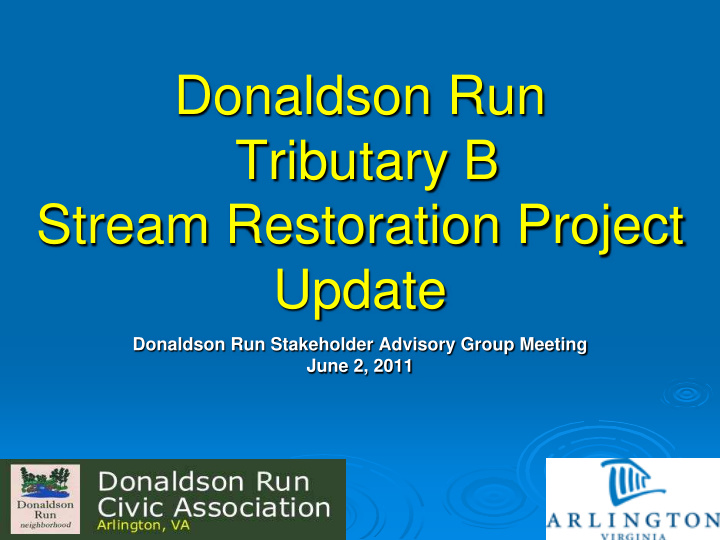



Donaldson Run Tributary B Stream Restoration Project Update Donaldson Run Stakeholder Advisory Group Meeting June 2, 2011
Review of changes from 30% to 60% design � Reducing width of channel/floodplain to reduce footprint and tree/valley impacts � Limiting re-location of pathway and narrowing pathway � Reducing disturbance and tree impacts below the footbridge
Updates from 60% design to 75% in February 2011 � Step pool ‘grade control’ and ‘riffle’ structures � Initial analysis of hillside and storm pipe drainage inputs � Initial water main survey � Preliminary planting plan � Invasive plant management framework
Updates from 75% design to 90% design Hydraulic analyses � Vertical elevation of water main (pending) � Hillside and storm pipe drainage inputs � l Meetings with specific property owners l Easement research l Preliminary design Advancement of planting plan and invasive plant � management strategy Consideration of construction access, equipment � type, future maintenance access
Hillside drainage inputs � Working with specific property owners � Accommodating flow inputs in project design
Storm pipe drainage inputs � Verifying easements/pipe conditions � Incorporating needed repairs/modifications into project design
Storm pipe drainage inputs – next steps � Complete easement research – meet with specific property owners � At least one new easement may be needed � TV inspection of all three pipes � Finalize designs that control stream energy and minimize future maintenance
30” Water Main � Interim work completed to protect exposed pipe � Completed horizontal location survey in January � May - Small borings excavated to confirm pipe elevations � Data analysis pending � Few apparent conflicts with stream restoration design except at stilling basin – TBD � Considering reinforced streambed crossings for future access to main if needed
Trees � No change in tree impacts from project from 60% designs to current design � One tree removed to protect water main (previously listed as a potential removal) � One tree has fallen (previously listed as a removal) � Project impact: 36 trees>10” diameter, 72 trees overall
Invasive Management & Planting Plan Goals: � To restore forest structure and function � To support recreational use and aesthetics
Kudzu Invasive Plants � 85-95% invasive species in the shrub and ground layers � invasive species present on both park and private properties � 27 different species
Implications � Invasive management considerable component of the project � Project requires integrated planting and invasive plant removal � 4-6 year planting and invasive plant maintenance schedule � Complete removal of invasive species is likely not possible � Most successful if private citizens are involved in invasive management
Invasive Management Actions to Date � Invasive plant removal workday, April 2 � Invasive Plant Workshop – Upshur St, May 1 – Hosted by Amy White � Invasive Plant Workshop – Stuart St, May 17 – Hosted by Sarah & Jeffrey Knight � PRCR sprayed lesser celandine along both Tributary B and Tributary A Need help from the Civic Association to generate volunteer turn out and ideas on how to recruit additional volunteers
Invasive Management Actions - Next Steps � In the future, a spring and fall event will be held on both Tributary A and Tributary B � Coordination with or expansion of the 2 existing RIP teams (Remove Invasive Plants) working in Zachary Taylor Park and coordination with Arlington Master Naturalists is being pursued � Possibly one more invasive plant workshop to engage homeowners is under consideration for fall 2011
Invasive Management – Looking Ahead � During construction/planting “Clean” equipment l Mulch or mats for trees/shrubs l Seed heavily l Protect deer candy l � Post-Project/Maintenance • Protect trees and shrubs • Focus on stream banks • Target species • Coordinate invasive removal and planting • Timing of control will depend on plant life cycle • Flexible and adaptive
Planting Plan � Site specific � All plants will be native to Zachary Taylor Park � Planting “zones” to account for habitat changes with elevation and distance from the stream. � Special plantings for sensitive areas � Multi-year to account for invasive control and natural forest succession
Zoned Planting - Example Slope Floodplain
Special Areas – Bare Slopes
Scarlet oak Arrowwood Bluestem goldenrod Quercus coccinea Viburnum dentatum Solidago caesia
Construction methods, equipment, & materials
Smaller materials and equipment
Smaller materials and equipment
Tree protection mats
Step pools and Step run feature
Next Steps � Continue work with property owners on hillside drainage inputs and design work for storm pipe drainage inputs � Finalize planting plan and invasive plant management plan � Develop construction access/staging plan � Complete specifications including tree protection plan � Target design completion by end of year � Construction schedule still TBD
Tributary A, June 2010 Stream restoration, watershed retrofits, Chesapeake Bay Preservation Ordinance, Stormwater Permit and more…. Learn more at: www.arlingtonva.us – search “Donaldson Run.”
Recommend
More recommend